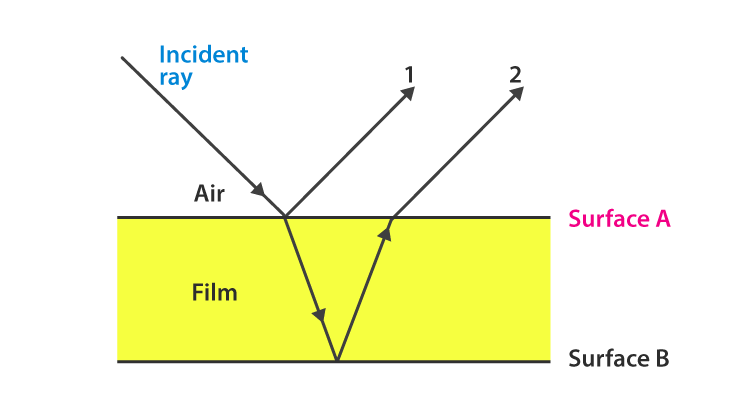
Colors of thin films result from or
On a rainy day, a small oil on water shows brilliant colors. This is due to
A. Dispersion of light
B. Interference of light
C. Absorption of light
D. Scattering of light
Answer
464.7k+ views
Hint: In order to solve this kind of question we should know the phenomena of interference. Interference explains what happens when two or more waves superpose each. Then we are able to find the correct solution to the above problem.
Complete step by step answer:

The above diagram shows how the light rays which pass through thin film and resulting interference phenomena.
Thin-film interference occurs in our daily life. In certain cases, we must have observed the colors of the rainbow which reflect on the bubble. This effect is known as thin film interference.
Thin film interference is the phenomenon that is a result of light waves being reflected off two surfaces that are at a distance comparable to its wavelength. When light waves that reflect off the top and bottom surfaces interfere with one another we see different colored patterns. Hence we can see some part of light which transmits and some part reflects.
When the second medium is a thin film, there are two reflections occurring close together at the top and bottom boundary surfaces of the thin film. Thus, there are two waves emerging from a thin film – one wave reflected off the top surface of the film and the other reflected off the bottom surface.
Colors of thin film are due to interference of light.
Hence the correct option is B.
So, the correct answer is “Option B”.
Note:
Phase difference between two waves is zero in the soft reflection because of less refractive index.
Phase difference between two waves λ/2 is in the hard reflection because of greater refractive index.
Complete step by step answer:

The above diagram shows how the light rays which pass through thin film and resulting interference phenomena.
Thin-film interference occurs in our daily life. In certain cases, we must have observed the colors of the rainbow which reflect on the bubble. This effect is known as thin film interference.
Thin film interference is the phenomenon that is a result of light waves being reflected off two surfaces that are at a distance comparable to its wavelength. When light waves that reflect off the top and bottom surfaces interfere with one another we see different colored patterns. Hence we can see some part of light which transmits and some part reflects.
When the second medium is a thin film, there are two reflections occurring close together at the top and bottom boundary surfaces of the thin film. Thus, there are two waves emerging from a thin film – one wave reflected off the top surface of the film and the other reflected off the bottom surface.
Colors of thin film are due to interference of light.
Hence the correct option is B.
So, the correct answer is “Option B”.
Note:
Phase difference between two waves is zero in the soft reflection because of less refractive index.
Phase difference between two waves λ/2 is in the hard reflection because of greater refractive index.
Recently Updated Pages
Master Class 12 Economics: Engaging Questions & Answers for Success

Master Class 12 Maths: Engaging Questions & Answers for Success

Master Class 12 Biology: Engaging Questions & Answers for Success

Master Class 12 Physics: Engaging Questions & Answers for Success

Master Class 12 Business Studies: Engaging Questions & Answers for Success

Master Class 12 English: Engaging Questions & Answers for Success

Trending doubts
Which are the Top 10 Largest Countries of the World?

Differentiate between homogeneous and heterogeneous class 12 chemistry CBSE

Draw a labelled sketch of the human eye class 12 physics CBSE

What is the Full Form of PVC, PET, HDPE, LDPE, PP and PS ?

What is a transformer Explain the principle construction class 12 physics CBSE

What are the major means of transport Explain each class 12 social science CBSE




